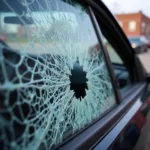Spot painting a car can seem daunting, but with the right knowledge and preparation, it’s a task many car owners can tackle themselves. This guide provides a comprehensive step-by-step approach to how to do a spot paint repair on a car, helping you achieve professional-looking results and save money. You’ll learn the essential techniques and tips for a seamless blend, restoring your car’s appearance to its former glory.
Getting a perfect spot paint repair requires careful preparation. First, thoroughly clean the damaged area with soap and water, then degrease it with a wax and grease remover. This ensures the paint adheres properly. Next, assess the damage. If there’s any rust, you’ll need to remove it completely before proceeding. A spot repair works best on small chips and scratches. For larger areas or more significant damage, you might consider professional car paint repair middlewich.
Preparing the Area for Spot Painting
Proper preparation is crucial for a successful spot paint repair. Start by sanding the damaged area with fine-grit sandpaper (around 2000-grit) to smooth out any imperfections and create a good surface for the new paint to adhere to. Feather the edges of the sanded area to blend it seamlessly with the surrounding paint. Clean the area again to remove any sanding dust. Finally, mask off the surrounding area with painter’s tape and paper to protect it from overspray. Accuracy in this stage will contribute significantly to a professional-looking finish.
Applying the Paint and Clear Coat
Once the area is prepped, apply thin coats of primer to the damaged area, allowing each coat to dry completely before applying the next. Once the primer is dry, apply the matching touch-up paint in thin, even coats. Avoid applying too much paint at once, as this can lead to runs and drips. Let each coat dry thoroughly before applying the next. How many coats you’ll need depends on the color and the depth of the damage.
After the color coat, apply a few coats of clear coat to protect the paint and give it a glossy finish. Follow the manufacturer’s instructions for drying times between coats.
Wet Sanding and Polishing
After the clear coat has dried completely, you may notice some slight imperfections or orange peel. Wet sanding with very fine-grit sandpaper (3000-grit or higher) can help smooth out these imperfections. This process requires patience and a gentle touch. Be careful not to sand through the clear coat. After wet sanding, polish the area with a rubbing compound and then a polishing compound to restore the shine and blend the repair seamlessly with the surrounding paint. If you are facing rust issues, check out our guide on how to repair rust on car paint.
What are the essential tools for a spot paint repair?
You’ll need sandpaper, masking tape, primer, touch-up paint, clear coat, rubbing compound, polishing compound, and applicators.
How long does a spot paint repair take?
The entire process, including drying time, can take anywhere from a few hours to a couple of days, depending on the extent of the damage.
Can I spot paint a metallic or pearlescent finish?
Yes, but it’s more challenging to match these finishes perfectly. Consider car paint delamination repair for more serious damage.
“Precise color matching and careful blending are essential for a successful spot repair. Don’t rush the process, and remember that patience is key to achieving professional-looking results,” advises John Smith, Automotive Refinishing Specialist at Smith Auto Body.
In conclusion, spot painting a car is a manageable DIY project that can save you money and restore your car’s appearance. By following these steps and paying attention to detail, you can achieve a seamless repair that blends flawlessly with the surrounding paint. For specific locations, consider checking car paint repair dublin 6 or door jam on car paint repair. Remember to take your time, be patient, and don’t be afraid to seek professional help if needed. A perfect spot paint repair involves meticulous preparation, careful application, and patience.
FAQ
- What type of paint should I use for a spot repair? Use automotive touch-up paint that matches your car’s color code.
- Can I spot paint over a dent? Small dents can be filled with glazing putty before painting.
- How do I match the paint color perfectly? Locate your car’s color code and purchase touch-up paint specifically formulated for that code.
- What if the spot repair is still visible? Professional detailing or further wet sanding and polishing might be necessary.
- How can I prevent future paint chips? Protective films or coatings can help protect your car’s paint.
- Can I use a spray can for spot painting? Yes, but practice on a test panel first to control the spray pattern.
- What is the best temperature for spot painting? Ideal temperatures are between 60°F and 80°F (15°C and 27°C).
Need help with your car repair? Contact us via WhatsApp: +1(641)206-8880 or Email: [email protected]. Our customer service team is available 24/7.

